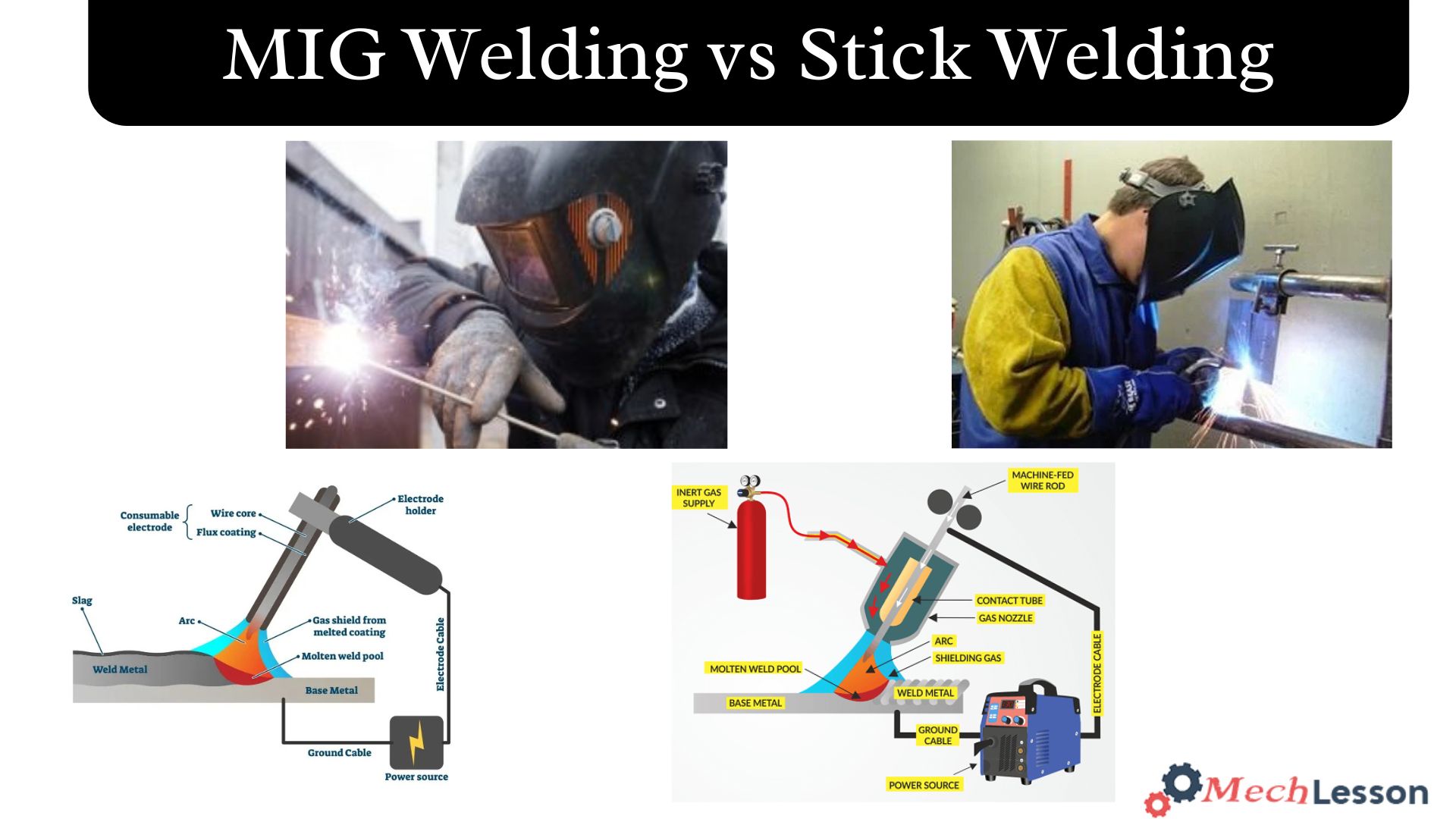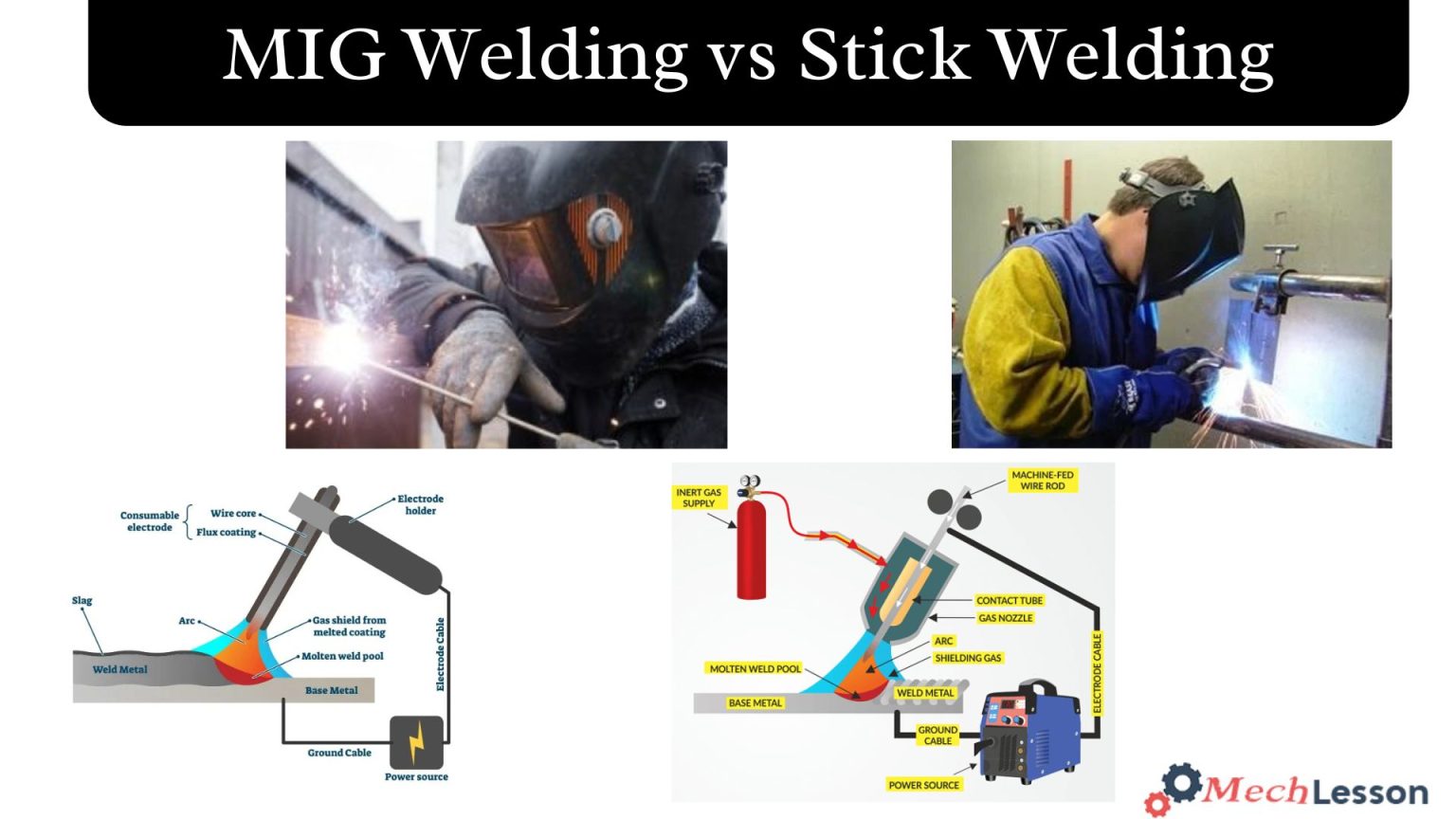Stick and MIG are now the three most widely used welding methods. Every procedure has advantages and disadvantages of its own. Making the right decision will save you a lot of time and aggravation.
We are all aware of how crucial it is to choose the appropriate instrument for the task. When it comes to welding, the method you use is just as crucial as the equipment. Attempting to use a screwdriver to cut a 2×4 might be analogous to using the incorrect welding technique for a given operation. I wish you luck in your endeavour.
Well, in this reading, we’ll explore what MID vs Stick welding is, its diagram, advantages and disadvantages. We’ll also explore the differences between them, and there maintain cost.
Let’s begin!
Read about Fricton Stir Welding with this detailed guide!
What is MID Welding?
MIG welding is a consumable electrode that is delivered from a spool. Pulling the trigger on the spool gun feeds the wire at a preselected speed as a current passes through, melting both the electrode and the base metal.
MIG welding is often performed with reverse polarity or DC (direct current), in which the base metal is negatively charged and the electrode is maintained positively charged. In either scenario, a shielding gas keeps the molten metal weld pool, which is formed when the base metal and electrode melt together, safe from external air contamination.
Since most MIG machines only have three settings for wire speed, polarity, and voltage, the equipment utilised by MIG welders is very basic and easy to understand. Because it has an on/off switch and a trigger, the welding machine spool gun is also simple to use.
Advantages of MID Welding
These are the following advantages of MID welding:
- High precision: can weld thin metal up to 24 gauge and create intricate designs.
- Clean: Offers smooth, high-quality, slag-free joins with minimal clean-up.
- Efficient: No need to interrupt welding work to replace stick rod electrode.
- Fast: One of the fastest welding methods, leading to high productivity.
- Easy-to-Learn: Easy to learn and operate, allowing beginners to create acceptable welds.
Disadvantages of MID Welding
Here are the main disadvantages of MIG Welding:
- Outdoor welding: This can be disrupted by even a slight breeze, causing weak, porous welds.
- Contamination: At the weld point, it can lead to porous welds, making it unsuitable for rust or paint-covered metals.
- Spool changes: These are necessary when welding different metals, despite the wire spool’s ease of use.
Read about Aluminum Gas Welding with this detailed guide!
What is Stick Welding?
Stick welding is a type of electric arc welding in which a metal rod or stick is used as filler material. These sticks come in various diameters and lengths and are often coated in a flux substance.
It is crucial to select the appropriate flux core wire welding rod type for your application in order to produce high-strength welds. Similar to MIG welding, stick welding employs a DC or reverse polarity current to weld steel and iron. The welding rod or stick and the base metal form an arc as a result.
This arc’s heat melts the filler rod and the base metal, causing droplets to flow into the workpiece and create beads that fuse the two metal pieces together.
A shielding gas that aids in arc stabilisation is produced when some of the flux vaporises due to the heat. To shield the weld from oxidation or contamination, the remaining flux generates slag on the molten melt pool. When flux is used instead of MIG welding, an external gas source is not required.
Advantages of Stick Welding
These are the advantages of stick welding:
- Environmentally friendly: Creates a large, unaffected arc, suitable for indoor and outdoor use.
- Paint and corrosion resistance: Ideal for repairing parts with paint or corrosion.
- Easy-to-learn: allows for quality welds with minimal experience.
- Filler material change: Allows for welding different metals like cast iron or stainless steel.
- Reduces burn-through: Allows for altering electrode polarity to minimise burn-through.
- Cost-effective: There is no need for an inert gas supply, making it an affordable option.
Read about Tack Welding with this detailed guide!
Disadvantages of Stick Welding
Here are the main disadvantages of Stick Welding:
- Deposits slag on metal: It requires scraping or chipping before further welding or painting.
- Produces spatter: In with DC welding producing less than AC welding.
- Welding thinner metals: Unsuitable less than 1/8” in thickness can, cause welding interruptions when replacing filler rod, reducing productivity.
Diagram

Read about Under-Water Welding with this detailed guide!
What are the different between MIG and Stick Welding
Stick and MIG welding both have the ability to create high-quality welds, but they differ greatly in their setups, benefits, drawbacks, and uses. In general, MIG welding is the torch that is easiest to use and the most straightforward type of welding to master.
Stick welding is more challenging to master, even though it may also be learnt quickly. Since the 1930s, stick welding has been the most traditional type of arc welding, and many seasoned welders still solely use it.
Both quantity and quality
Stick and MIG welding methods are both capable of producing excellent welds, but which equipment performs better depends greatly on the kind of metal. MIG welding is a superior option for producing a strong, clean union when working with thinner metals. The Stick performs best on metals that are thicker than ⅜ inch.
Because of its simplicity of operation, the MIG cannon can generate a large amount of work with little downtime. Because of this, it’s frequently utilised in fabrication and is also the preferred option for robotic welding processes.
Stick welding requires more time since it requires a warm-up when the gun is initially turned on and requires more regular downtime for electrode replacement. Cleaning When it comes to cleaning and cleanup, MIG and stick welders have different advantages and disadvantages. One requires more effort up front, while the other does it after the weld.
Stick welding eliminates the need for the pre-weld prep of cleaning the workpiece, which is necessary with a MIG setup, because it can create a strong union on even a dirty or rusty surface.
Stick welding, on the other hand, uses electrodes coated in flux, which produces spatter during the weld that needs to be chipped off after it cools. But with MIG, the shielding gas not only keeps the weld safe while it cools, it also removes any spatter. There is far less cleaning as a result.
Read about Spot Welding with this detailed guide!
Versatility
The ability to weld outdoors, in windy environments, or anywhere the shielding gas of a MIG system would be jeopardised is one of Stick’s greatest benefits over MIG.
In actuality, it may be wheeled to any location where the MIGwelder is restricted by the cable’s length. The flexibility to adjust the nozzle’s angle to weld in confined spaces or at odd angles is another benefit of a stick welder.
Maintainance And Cost
Here are some general considerations for the cost differences:
Labour Costs: Compared to stick welding, MIG welding is typically quicker and needs less expertise. Because stick welding requires more time and skill to finish the same length of weld, labour costs may be greater.
Electrode Costs: Stick welding employs consumable coated electrodes, whereas MIG welding uses consumable wire electrodes that are continually supplied from a spool. In general, stick electrodes are less expensive per pound, but, their decreased rate of deposition in comparison to MIG wire may result in greater material costs for stick welding per inch of weld.
Welding pace: Stick welding necessitates more starts and stops and frequent electrode changes, which slows down the total welding pace. In contrast, MIG welding is usually faster since it is a semi-automatic operation. The price per inch of weld may be affected by this variation in welding speed.
Waste and Cleanup: Slag from stick welding must be chipped off after welding, creating more waste and perhaps lengthening the cleanup period. In general, MIG welding produces less waste and can need less cleaning after the weld.
Equipment Costs: If the equipment cost is taken into account, the total cost per inch of weld may be affected because MIG welding machines are often more expensive to buy than stick welding machines.
Power Consumption: Compared to stick welding, MIG welding may use less power, which might lead to cheaper energy expenses per inch of weld.
Joint Efficiency: The strength and joint efficiency of the weld can be impacted by the welding procedure utilised. The potential cost advantages from utilising MIG welding could be negated by the requirement for more welds or stronger materials if stick welding is more appropriate for particular kinds of connections or materials.
Read about Orbital Welding with this detailed guide!
FAQs
Is a MIG weld as strong as a stick weld?
QUALITY and QUANTITY. Both MIG and Stick welding systems can produce high-quality welds, but the type of metal makes a big difference in which machine works better.
For thinner metals, MIG welding is the better choice for creating a clean, strong joint. On thicker metals — over ⅜ inch — the Stick has better performance …
What is a disadvantage of MIG welding?
Disadvantages of MIG Welding
Welders will notice right away that MIG welding equipment is more complex and costly, while also sacrificing portability. In addition, shielding gas, electrodes, and replacement tips and nozzles for MIG welding can add up.
Which welding is strongest?
What Type Of Weld Is The Strongest? TIG welding is often considered the strongest weld since it produces extreme heat, and the slow cooling rate results in high tensile strength and ductility.
MIG is also an excellent candidate for the strongest type of weld because it can create a strong joint.
Why MIG welding is better?
When compared with Stick welding, the mig welding process is faster, easier, and requires little cleanup of welds. This makes Mig welding cost effective for production welding in fabrication shops.
The wire fed welding arc is capable of joining thin sections and bridging gaps in poor fit up situations”.

